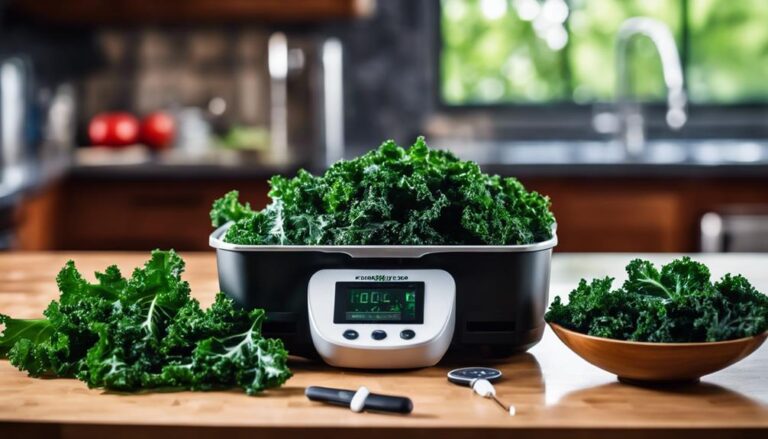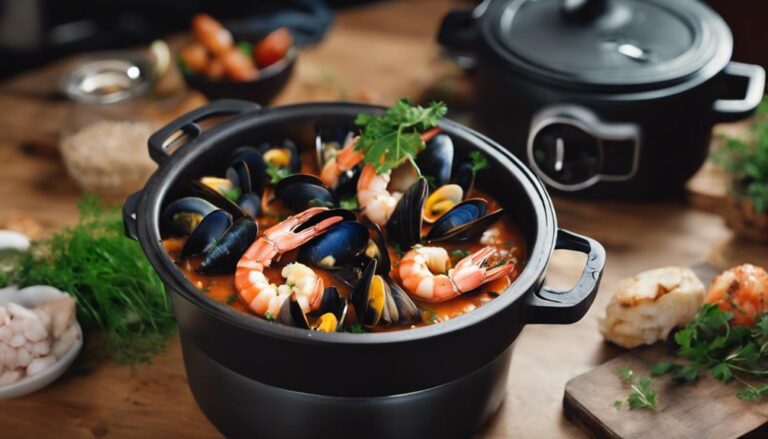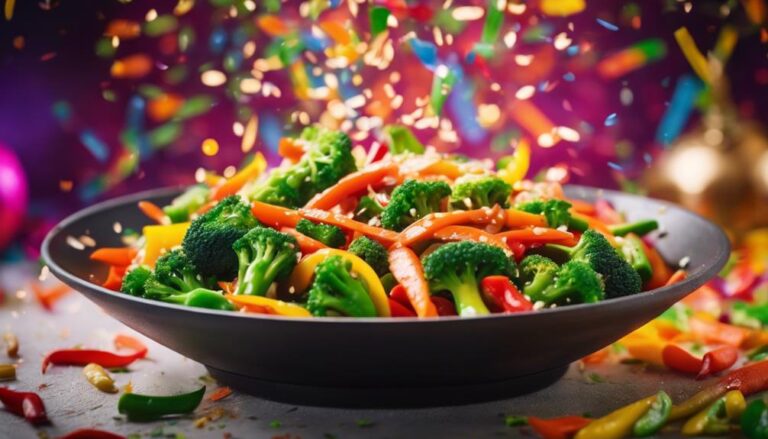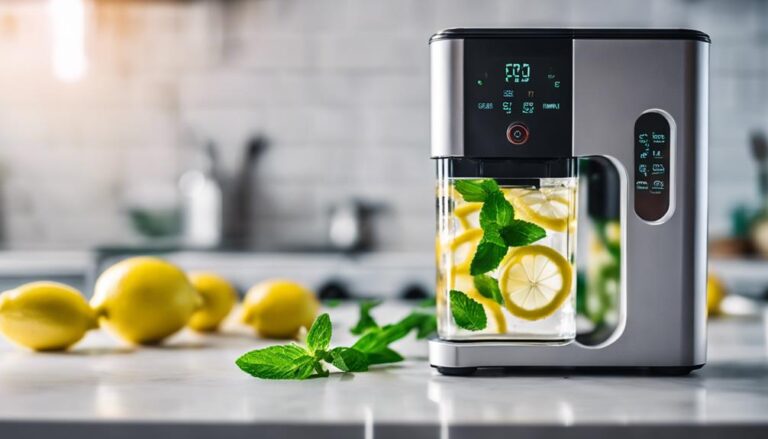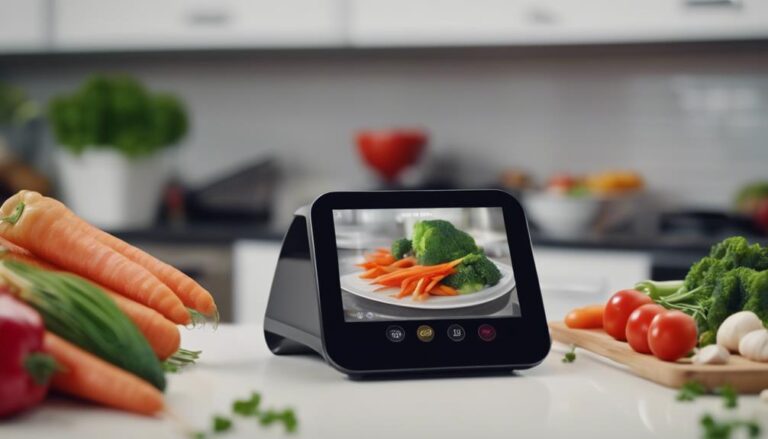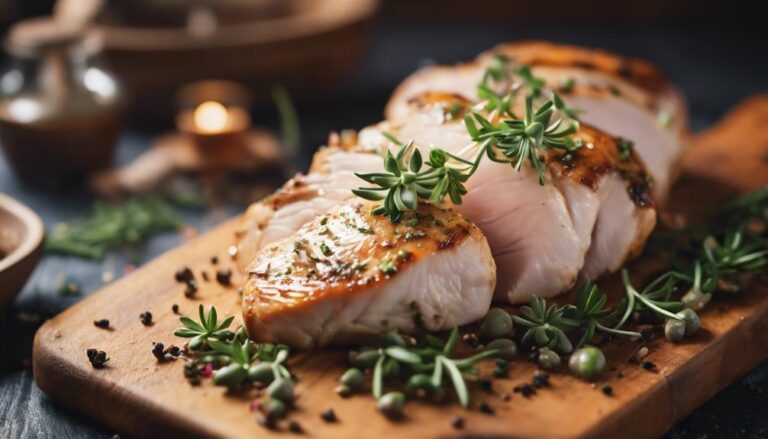Five-Point Sous Vide Filet Mignon With Balsamic Reduction
First, season your filet mignon with salt and pepper, and marinate it in a mix of balsamic vinegar and red wine for added depth. Vacuum-seal the steak to lock in flavors and moisture. Set your sous vide to precisely 130°F for medium-rare perfection, and immerse the sealed steak for two hours to guarantee even cooking. Post-sous vide, sear the filet in a hot skillet for 1-2 minutes each side to develop a flavorful crust. Drizzle with a balsamic reduction before serving to enhance the dish. Exploring these techniques further, you'll discover additional tricks to perfect your culinary skills.
What You Will Learn Here
- Marinate filet mignon in balsamic vinegar and red wine to infuse deep flavors before sealing.
- Sous vide the steak at 130-135°F for precise medium-rare doneness.
- Cook in a vacuum-sealed bag for 1-4 hours, depending on thickness.
- After sous vide, sear the steak briefly in a hot pan to develop a caramelized crust.
- Serve with a drizzle of balsamic reduction for added richness and flavor enhancement.
Origins of Sous Vide Cooking
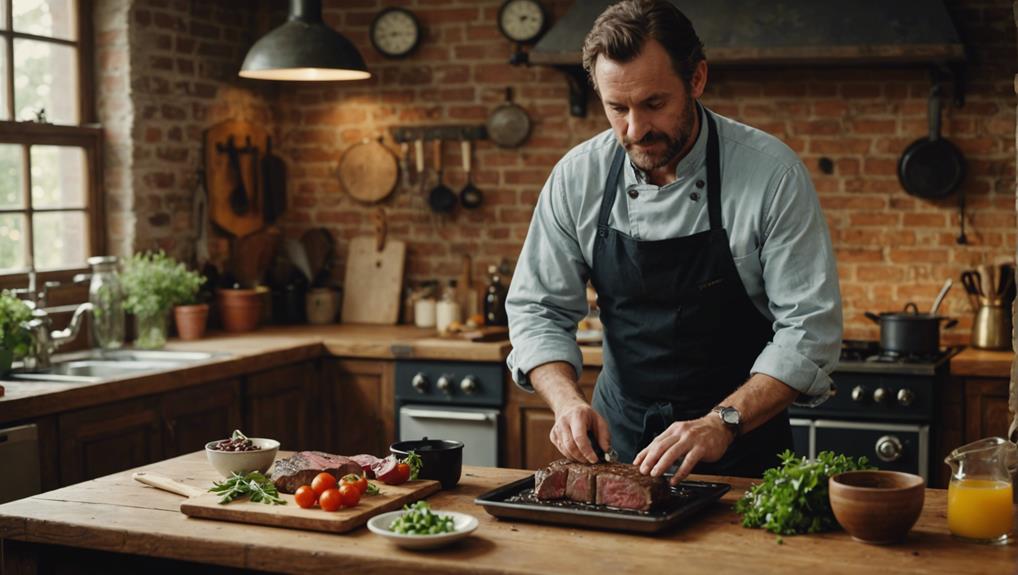
You'll find that sous vide cooking, developed in the 1970s by Chef Georges Pralus, revolutionized culinary techniques with its precision.
This method, translating to 'under vacuum', involves sealing food in airtight bags and submerging it in a water bath at a meticulously controlled temperature.
This technique not only spread rapidly across professional kitchens due to its ability to guarantee consistent and best culinary results but also evolved to become accessible for home cooks, altering meal preparation greatly.
Sous Vide History
Sous vide cooking, a technique rooted in 1970s France, was pioneered by Chef Georges Pralus and later championed by Chef Bruno Goussault, transforming precise temperature-controlled cooking.
This method, meaning 'under vacuum' in French, involves vacuum-sealing food in airtight bags and submerging them in a water bath where temperatures are meticulously controlled. This revolutionary approach allows for unparalleled precision in cooking, ensuring that foods like meats and vegetables are cooked evenly and retain excellent flavor and texture.
Initially reserved for the domain of fine dining, sous vide set a new standard for culinary excellence, allowing chefs to achieve consistent, repeatable results that were previously unattainable with traditional cooking methods. This technique has since become a cornerstone in the art of fine dining preparation.
Modern Culinary Adoption
Developed by Georges Pralus in the 1970s, sous vide cooking uses vacuum-sealed bags and precise temperature control to uniformly cook food. This technique, crucial for your Filet Mignon recipe, guarantees consistent results and enhances flavors with exact cooking degrees. Adopt this modern culinary trend in your home cooking to serve sous vide steaks with a balsamic reduction, achieving restaurant-quality dishes.
| Feature | Benefit | Example |
|---|---|---|
| Precise Temperatures | Ensures even cooking | Filet Mignon at 135°F |
| Vacuum-Sealed Bags | Retains moisture | Juicier steaks |
| Time Efficiency | Plan with flexibility | 1 hour cook time |
| Consistent Results | Perfect every time | Reliable doneness |
| Modern Equipment | Accessible and user-friendly | Anova, Chefman |
Embrace sous vide to elevate your culinary skills and delight your guests with perfection every serving.
Technique Evolution
Emerging in the 1970s, sous vide cooking revolutionized precision in gourmet kitchens by enabling chefs to maintain exceptional quality and consistency in their dishes. French chefs pioneered this method, vacuum-sealing filet mignon in airtight bags to achieve precise control over the cooking process. By immersing these sealed packages in a water bath at meticulously controlled temperatures, they guaranteed that the meat cooked evenly, enhancing its natural flavors and textures.
This technique evolution allowed for the creation of exquisite dishes like filet mignon with balsamic reduction, where the reduced sauce complements the tender, perfectly cooked meat. Sous vide's ability to maintain water bath temperature with exactitude transformed culinary practices, ushering in a new era of consistency and excellence in food preparation.
Essential Sous Vide Components
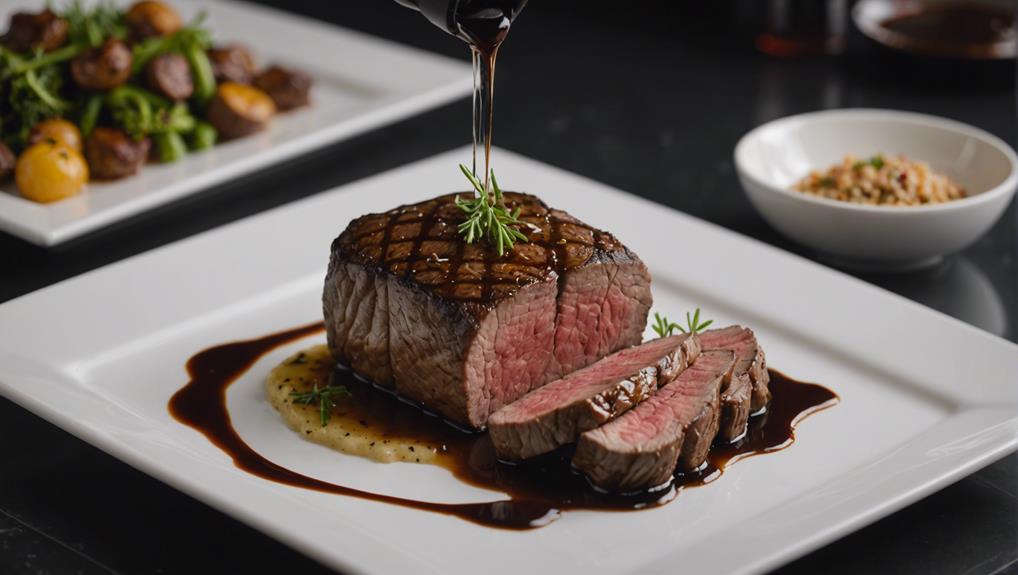
To achieve precise temperature control in sous vide cooking, you'll need an immersion circulator, a device essential for maintaining consistent heat throughout the cooking process. This tool is crucial for your culinary adventures, especially when preparing a delicate filet mignon. By vacuum-sealing the steak, you guarantee that all the flavors and juices are tightly locked in, creating a base for an exquisite meal that's further enhanced by your balsamic reduction.
The beauty of sous vide is in its meticulous nature. With an immersion circulator, you can set the exact temperature required for the doneness you desire—whether it's a rare, medium, or well-done steak. Remember, achieving the perfect sear post-sous vide is just as critical. This step catalyzes the Maillard reaction, forming a deliciously crisp crust that contrasts beautifully with the tender interior of your filet mignon.
Here's why every step in this process matters:
- Consistent Cooking: Your immersion circulator prevents temperature fluctuations that can ruin the texture of your filet mignon.
- Flavor Retention: Vacuum-sealing the meat ensures that all the seasonings and marinades infuse deeply, elevating the taste with every bite.
- Precision: You can fine-tune the cooking parameters to suit each guest's preference, showcasing your dedication to their dining experience.
As you master these techniques, you'll not only refine your cooking skills but also enhance the culinary enjoyment of those you serve, making every meal a memorable event.
Top Sous Vide Creations
As you explore top sous vide creations, consider starting with a Balsamic Sous Vide Filet. Infuse your steak with a mixture of fresh herbs by setting your immersion circulator to 130°F for medium-rare perfection.
For a richer flavor, opt for a Garlic Butter Sous Vide Steak, sealing your meat with a generous dollop of compound butter before cooking.
Balsamic Sous Vide Filet
Begin by marinating your filet mignon in a mixture of balsamic vinegar and red wine to infuse it with a robust flavor before sous vide cooking. This gourmet method not only saturates the meat with rich, tangy nuances but also readies it for the precise doneness that only sous vide can achieve. By cooking your filet mignon at a controlled temperature, you guarantee a tender, perfectly cooked steak that's both luxurious and satisfying.
The anticipation of slicing into the perfectly cooked filet, its juices mingling with the balsamic reduction
The pride in presenting such an elegantly prepared dish to guests
The joy of tasting the complex layers of flavor, a true culinary delight
Herb-Infused Sous Vide Steak
Elevate your steak by vacuum-sealing it with herbs like rosemary, thyme, and garlic to enhance its flavor through sous vide cooking. Using immersion circulators, you'll achieve precise temperatures that guarantee your sous vide steak is both tender and flavorful. The controlled heat allows the aromatic flavors of your chosen herbs to deeply infuse the meat, creating a taste experience that's hard to replicate with traditional methods.
- Savor Every Bite: The herbs release their essential oils, permeating the steak with rich, complex flavors.
- Perfect Consistency: Achieve the exact doneness you desire without the risk of overcooking.
- Creative Freedom: Experiment with customizable herb combinations to craft unique, memorable dishes for your guests.
Garlic Butter Sous Vide Steak
To create a luxuriously flavored sous vide steak, first infuse your butter with finely minced garlic, allowing it to permeate the steak throughout the cooking process. This method enhances the flavor profile and guarantees your Filet Mignon remains tender and moist.
Cook your steak sous vide at a precise temperature of 130°F (54°C) for best tenderness. Finish by searing briefly in the garlic butter to form a beautifully caramelized crust.
- Embrace the Elegance: Imagine the sheer joy of serving a dish that looks as splendid as it tastes.
- Savor the Aroma: The enticing scent of garlic butter creates a warm, inviting atmosphere.
- Indulge in Perfection: Each bite is a blend of rich flavors and velvety textures, a validation of your culinary prowess.
Sous Vide Precision Techniques
To achieve the perfect filet mignon, you'll need to set your sous vide machine to maintain a water bath at precisely 130-135°F, ideal for medium-rare results. Factor in the steak's thickness to adjust your cooking time, generally ranging from 1 to 4 hours, ensuring it's both tender and flavorful.
Don't forget the essential equipment: a reliable vacuum sealer and a heavy skillet for searing the steak post-sous vide to develop a rich, caramelized crust.
Optimal Cooking Temperatures
Setting the sous vide to precisely 130-135°F guarantees your filet mignon reaches a perfect medium-rare doneness every time. This precise control of the cooking temperature, central to sous vide precision techniques, guarantees your filet mignon remains tender and juicy. By maintaining this specific range in your water bath, you mitigate the risk of overcooking or undercooking the steak. The consistent temperature throughout the cooking process allows the fibers in the filet mignon to relax and reabsorb their juices, enhancing the meat's natural flavors.
The sous vide method, focusing on such precision, provides a foolproof way to achieve a restaurant-quality filet mignon right in your own kitchen. Delight your guests with the perfection in every bite.
Time Management Tips
Manage your cooking schedule effectively by planning to sous vide your filet mignon for 1 to 4 hours, depending on the steak's thickness and your desired texture. Utilize immersion circulators for consistent heat distribution, ensuring your filet mignon reaches the perfect level of doneness. This precise cooking technique, when paired with the art of searing post-sous vide, accentuates the steak's flavors, particularly when drizzled with a balsamic reduction.
To optimize your time management, adhere to these timing guidelines closely. Begin the sous vide process early enough to accommodate the full potential cooking time, allowing a window for searing and plating. This strategy guarantees that your filet mignon is ready to impress your guests with its impeccable taste and presentation.
Equipment Essentials
Acquire an immersion circulator to achieve precise temperature control essential for sous vide cooking. This tool allows you to set your water bath to the exact temperature needed for the doneness you desire in your filet mignon.
Utilize vacuum-sealed bags to encase your steak, ensuring that it's airtight and ready for immersion. This step is important as it prevents water from infiltrating the bag, thereby maintaining the integrity and flavor of the meat.
Once your steak has reached its perfect internal temperature, it's time to sear it quickly on high heat. This final step develops a flavorful crust, enhancing the succulent, evenly cooked interior achieved through precise cooking with your sous vide setup.
Final Thoughts
You've discovered that sous vide cooking allows for unparalleled precision in achieving the perfect doneness for your filet mignon. By employing precise cooking temperatures, this method guarantees that every inch of your steak reaches its ideal internal heat slowly and evenly, reducing the risk of overcooking dramatically. The sous vide technique, a staple in gourmet restaurant kitchens, has revolutionized how culinary enthusiasts like you approach home cooking, turning an ordinary dinner into a gourmet experience.
Adding a balsamic reduction to your filet mignon isn't just a touch—it's a transformation. This rich, glossy sauce introduces a depth of flavor that complements the meat's natural savoriness. Its tangy yet sweet character is enhanced further when paired with a glass of full-bodied red wine, elevating the dish to the level of a fine dining establishment.
The final flourish, blue cheese butter, is where your culinary creativity truly shines. This compound butter, melding the robust flavors of blue cheese with creamy butter, adds a complex layer of taste that melts lusciously atop the hot steak. It's these thoughtful additions that encapsulate the essence of high-end restaurant techniques in your own kitchen.
As you serve this meticulously prepared dish to your guests, remember that every step from choosing the right temperature to creating the balsamic reduction and blue cheese butter plays a pivotal role in crafting not just a meal, but an experience. Tonight, you're not just feeding your loved ones; you're offering them a slice of culinary excellence. Enjoy the accolades to come—they are well-deserved.
Frequently Asked Questions
How Long Should I Sous Vide a Filet Mignon?
You should sous vide your filet mignon for 1-2 hours, adjusting for thickness variations and desired doneness. Guarantee proper water circulation and vacuum sealing for best flavor infusion and end texture.
What Does Balsamic Vinegar Do to Steak?
Balsamic vinegar enhances steak's flavor by deepening color, adding complexity, and balancing acidity. It's used in marinades, glazes, and reduction techniques, adhering to culinary traditions to elevate dishes for your guests.
What Is the Best Temperature to Sous Vide Steak?
For sous vide steak, you'll find the ideal temperature is 130-135°F. This range guarantees efficient fat rendering, precise cooking, and even heat distribution, enhancing the steak's texture and flavor while maintaining safety.
Should You Season Steaks Before or After Sous Vide?
You should season steaks before sous vide to enhance flavor penetration, moisture retention, and spice impact. Proper salt concentration and seasoning types affect texture differences, improving crust formation and marinating effects during cooking.
Conclusion
As you finish your five-point sous vide filet mignon with balsamic reduction, guarantee precise temperature control at 57°C for prime tenderness.
Gently sear the steak post-sous vide to develop a rich, caramelized crust. Drizzle with your balsamic reduction, artfully reducing it to a syrupy consistency that complements the meat's succulence.
This meticulous approach marries modern culinary precision with classic flavors, enhancing your dining experience.
Relish each bite, a confirmation of the art of precision cooking.






